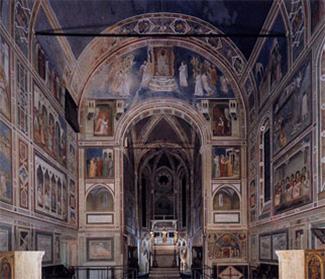7 Wall painting
To recover a sense of the paintings’ original meaning, however, we need to re-think them imaginatively, not as independent easel paintings but as fragments of a complex, inter-related scheme covering the walls of the tomb-chapel.
In our own artistic tradition, paintings on walls are called ‘mural’ paintings to distinguish them from self-contained ‘easel’ paintings. Some of the main sites of mural painting have been churches. It helps if we can think of the Nebamun paintings as having more in common with a scheme such as that in Giotto’s Arena Chapel (Figure 11) or in Michelangelo’s Sistine Chapel, than with a single oil painting of, say, a family group or a garden.

One of the things that wall paintings often do is to tell a story.
In the case of Renaissance schemes like Giotto’s or Michelangelo’s, or similarly in the case of medieval stained glass windows, these narratives are often Biblical. In the case of the Nebamun paintings, there is no single narrative key quite like this, but they do still add up to a story. The story they tell is of Nebamun’s life, his achievements, his status, his virtue, and by extension how he will enjoy more good things in another life after his own death, in the eternity of the afterlife.
